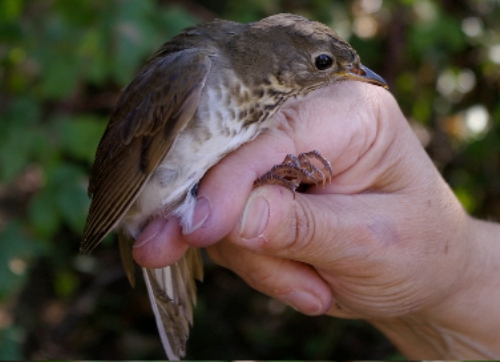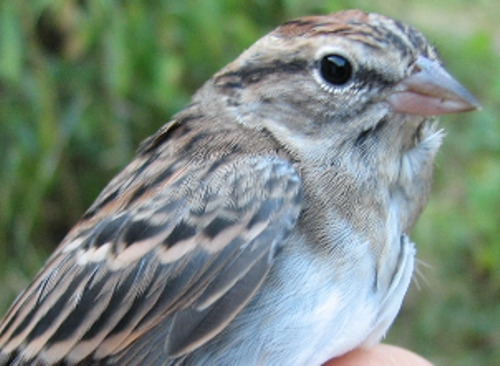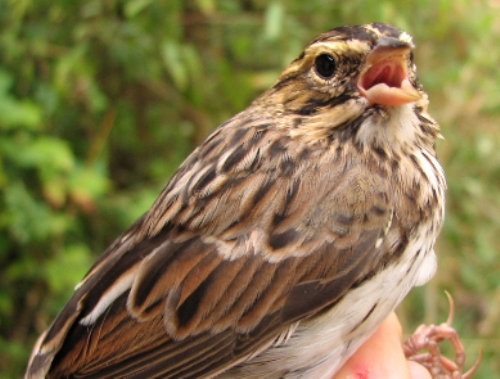|
Week 10: October 3-9, 2008 |
Welcome
to the McGill Bird Observatory weekly report.
Click here for a complete listing of our archives.
Comments or
questions are welcome at "mbo AT migrationresearch.org".
|
PICTURE
OF THE WEEK: |
|

This hatch-year Bicknell's Thrush may have been one of the young hatched this year
from the small population at Mont Tremblant - a reminder that there is the potential
for great surprises at MBO every morning.
(Photo by Barbara Frei)
|
|
|
THIS WEEK |
THIS FALL |
2008 TOTAL |
SITE TOTAL |
|
# birds (and species) banded |
1113 (40) |
4129 (74) |
4971 (83) |
17949 (105) |
|
# birds (and species) repeat |
153 (16) |
717 (42) |
915 (46) |
3141 (64) |
|
# birds (and species) return |
1 (1) |
24 (14) |
116 (22) |
447 (32) |
|
# species observed |
75 |
129 |
150 |
196 |
|
# net hours |
377.5 |
4541.3 |
7453.5 |
29399.3 |
|
# birds banded / 100 net hours |
294.8 |
90.9 |
66.8 |
61.0 |
|
|
Note: table does not include nocturnal banding (owls) |
|
Banders-in-charge: Barbara Frei, Marie-Anne Hudson, James Junda
Assistants: Jean Bacon, Jean-François Beauchemin, Louise Bédard, Christine Cadieux, Marie-Eve Campin, Sophie Cauchon, David Davey, Genevieve D’Avignon, Luc Farly, Nicki Fleming, Maura Forrest, Tiffany Gamelin, Tiffany Gilchrist, Gay Gruner, Cristina Guillamette, Meggy Hervieux, Marie-Mellissa Kalamaras, Kristen Keyes, Gillian Kinsman, Marjolaine Lagacé, Barbara MacDuff, Mike Mayerhofer, Betsy McFarlane, Chris Murphy, Chloé Nadeau-Perrier, André Pelletier, Brittney Roughan, Cat Spina, Rodger Titman, Brigette Zacharczenko
Notes: Peak migration is still underway at MBO! Remarkably the number of birds banded this week was exactly the same as last week, at a whopping 1113 - more than twice as many individuals banded this week as during week 10 of 2007. As well, we are at an unbelievable 2.5 times the number of birds banded overall this fall compared to last fall at this time.
Week 10 was a week with several highlights beyond the sheer number of birds banded. Three species were banded this week for the first time this fall – American Tree Sparrow, Fox Sparrow, and ... Bicknell’s Thrush! What a treat for the Monday crew, to find this rare thrush in the nets. Only one other Bicknell’s Thrush has been banded in the history of MBO. There is a small breeding population of these elusive birds in Mont Tremblant Park, which is probably the source of the rare individuals we've spotted at MBO during migration. Further proof that we never know what surprises await on any given morning, and how quickly an ordinary day can turn extraordinary. In addition, two more species were added to this fall's overall checklist – a Northern Goshawk and a pair of American Pipits.

As the warblers leave, they are replaced by a wider variety of sparrows - a group that usually blesses MBO with both a good diversity and abundance of birds. This hatch-year Chipping Sparrow is the smallest of the species we reguarly see at MBO.
(Photo by Barbara Frei)
|
For the top ten banded this week, very little has changed in the top three spots, with the Yellow-rumped Warblers still in a very clear lead, despite a small drop in numbers - hard as it still is to believe that 649 in one week could be considered a reduced quantity. Like last week they were followed by Ruby-crowned Kinglet and White-throated Sparrow, each of which increased slightly in numbers. While they both topped the 100 bird mark for the week, the Yellow-rumped Warblers overshadowed them to such an extent that their peak wasn't evident until we looked at the total numbers at the end of the week. Song Sparrow and American Robin both jumped up several spots in the list, as their late season migration became more evident. Nashville Warblers were the only other warbler to make it into the top ten this week, with most others now having made their way well to the south already.
This week’s
top 10
[last week’s rank in brackets]
#
individuals banded |
mean # individuals observed daily |
1. Yellow-rumped Warbler (650) [1] |
1.
Canada Goose (428) [1] |
2.
Ruby-crowned Kinglet (126) [2] |
2.
Yellow-rumped Warbler (178) [3] |
3.
White-throated Sparrow (100) [3] |
3.
American Robin (108) [4] |
4.
Song Sparrow (32) [5] |
4. American Crow (106) [2] |
5.
American Robin (28) [-] |
5. Common Grackle (85) [8] |
6.
Slate-coloured Junco (23) [10] |
6.
White-throated Sparrow (57) [7] |
7.
Nashville Warbler (21) [4] |
7. Red-winged Blackbird (50) [6] |
8. White-crowned Sparrow (19) [-] |
8.
Ruby-crowned Kinglet (49) [5] |
9. Golden-crowned Kinglet (14) [-] |
9.
Blue Jay (18) [9] |
10. Hermit Thrush (12) [-] |
10. Black-capped Chickadee (17) [-] |
|
Canada Geese were still seen in large flocks daily this week. The Yellow-rumped Warblers jumped up to the second most frequently observed species of the week - it's not often that a small songbird beats out the large and noisy flocks of robins, crows, and blackbirds for such a prominent spot on the list, but it reflects the sheer number of these little guys around! The remainder of the top ten species are all common fall birds for the station. With an average of 1000+ individuals seen on site each day, MBO has been a busy place indeed this week 10.

Another of the less commonly seen sparrows at MBO is the Savannah Sparrow, which resembles the much more abundant Song Sparrow to an extent. The Savannah has smaller, finer streaks on the breast, and distinctly yellow patches in the supercilium (over the eyes). Our local breeders have already migrated, so these later individuals are likely from the numerous bogs and grassy wetlands in northern Ontario, Quebec, or Labrador.
(Photos by Barbara Frei)
|



